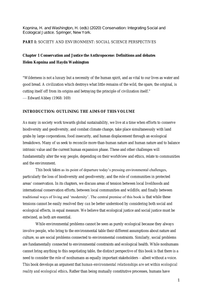As many in society work towards global sustainability, we live at a time when efforts to conserve biodiversity and geodiversity, and combat climate change, take place simultaneously with land grabs by large corporations, food insecurity, and human displacement through an ecological breakdown. Many of us seek to reconcile more-than-human nature and human nature and to balance intrinsic value and the current human expansion phase. These and other challenges will fundamentally alter the way people, depending on their worldview and ethics, relate to communities and the environment. While environmental problems cannot be seen as purely ecological because they always involve people, who bring to the environmental table their different assumptions about nature and culture, so are social problems connected to environmental constraints. Similarly, social problems are fundamentally connected to environmental constraints and ecological health. While nonhumans cannot bring anything to this negotiating table, the distinct perspective of this book is that there is a need to consider the role of nonhumans as equally important stakeholders – albeit without a voice. This book develops an argument that human-environmental relationships are set within ecological reality and ecological ethics. Rather than being mutually constitutive processes, humans have obligate dependence on nature, not vice versa. We argue that over-arching ecological ethics is necessary to underpin conservation in the long-term. This requires a holistic ‘justice’, where both social justice (for humans) and ecological justice (for nature) are entwined. However, given the escalating environmental crisis and major extinction event we face, and given that social justice has been dominant for centuries, we believe that in many cases ecojustice will need to be prioritized. This will depend on the situation, but we feel that under ecological ethics, holistic ethics cannot always allow social justice to dominate, hence there is an urgent need to prioritize ecojustice today. Accordingly, this book will deal with questions of both social and ecological justice, putting forth the idea that justice for both humans and nonhumans and their habitats can only be achieved simultaneously. This book will explore the following questions: What is the relationship between social and ecological justice? How might we integrate social and ecological justice? What are the major barriers to achieving this simultaneous justice? How can these barriers be overcome? What are the major debates in conservation relevant to this? doi: 10.1007/978-3-030-13905-6 LinkedIn: https://www.linkedin.com/in/helenkopnina/
MULTIFILE

Er is wereldwijd een groeiende groep milieuvluchtelingen waarvoor nog geen internationaal beschermingsregime bestaat. Het internationaal recht biedt geen adequaat antwoord. Dit artikel laat zien welke soorten milieuvluchtelingen bestaan, en zal betogen dat de bescherming van deze groep plaats kan vinden onder het VN-principe The Responsibility to Protect (R2P). Staten en de internationale gemeenschap hebben een zorgplicht voor milieuvluchtelingen. De basis hiervan ligt bij de Rechten van de Mens. De effectieve uitvoering van een aantal basisrechten wordt immers negatief beïnvloed door milieudegradatie. Tevens wordt staatssoevereiniteit steeds meer beschouwd als een verantwoordelijkheid. Via The Responsibility to Protect ontstaat er een integrale aanpak: 1) een staat is ten eerste zelf verantwoordelijk voor de bescherming van milieuvluchtelingen, 2) de internationale gemeenschap heeft een verantwoordelijkheid een staat hierbij te assisteren, en 3) indien een staat zijn milieuvluchtelingen niet wil of niet kan beschermen, verschuift de verantwoordelijkheid voor dit probleem naar de internationale gemeenschap, om collectief snel en beslissend te reageren. ABSTRACT The number of environmental refugees is growing, but an international legal protection regime is non-existent. This article shows eight different kinds of environmental refugees, and will argue that the protection of these groups can take place under the UN principle The Responsibility to Protect (R2P). States and the international community are obliged to help environmental refugees, based on the International Bill of Human Rights. The effective implementation of basic rights is influenced negatively by environmental degradation. Furthermore, changed notions regarding state sovereignty are also pointing at the responsibility of the state. The Responsibility to Protect (R2P) offers an integral approach: In first instance, the responsibility to take protective measures lies with the state itself. Secondly, the international community has a responsibility to assist. Lastly, when a state is not able or willing to protect its environmental refugees, the responsibility yields to the international community, to respond in a swift and decisive manner.
DOCUMENT

Social scientists of conservation typically address sources of legitimacy of conservation policies in relation to local communities’ or indigenous land rights, highlighting social inequality and environmental injustice. This chapter reflects on the underlying ethics of environmental justice in order to differentiate between various motivations of conservation and its critique. Conservation is discussed against the backdrop of two main ethical standpoints: preservation of natural resources for human use, and protection of nature for its own sake. These motivations will be examined highlighting mainstream conservation and alternative deep ecology environmentalism. Based on this examination, this chapter untangles concerns with social and ecological justice in order to determine how environmental and human values overlap, conflict, and where the opportunity for reconciliation lies, building bridges between supporters of social justice and conservation. https://www.springer.com/gp/book/9783319713113#aboutBook LinkedIn: https://www.linkedin.com/in/helenkopnina/
MULTIFILE

Climate change is now considered more than just an environmental issue, with far-reaching effects for society at large. While the exact implications of climate change for policing practice are still unknown, over the past two decades criminologists have anticipated that climate change will have a number of effects that will result in compromised safety and security. This article is informed by the outcome of a co-creation workshop with 16 practitioners and scholars of diverse backgrounds based in The Netherlands, who sought to conceptualize and systematize the existing knowledge on how climate change will most likely impact the professional practice of the Dutch (or any other) police. These challenges, with varying degrees of intensity, are observable at three main levels: the societal, organizational, and individual level. These levels cannot be separated neatly in practice but we use them as a structuring device, and to illustrate how dynamics on one level impact the others. This article aims to establish the precepts necessary to consider when exploring the intersection between climate change and policing. We conclude that much still needs to be done to ensure that the implications of climate change and the subject of policing are better aligned, and that climate change is recognized as an immediate challenge experienced on the ground and not treated as a distant, intangible phenomenon with possible future impacts. This starts with creating awareness about the possible ways in which it is already impacting the functioning of policing organizations, as well as their longer-term repercussions.
MULTIFILE

This article aims to gauge students’ perceptions of the Dutch Party for Animals (PvdD) in order to reflect on the political representation of nonhumans (animals). The support for political representation of nonhumans is based on the ethical underpinning of deep ecology; growing recognition of the importance of sustainability; and increased societal support for animal rights and welfare. This article reflects on these developments using Bachelor students’ assignments from a Sustainable Business course, which asked them to reflect on the underlying principles of the PvdD. Student assignments indicate that educational efforts targeted at fostering ecological citizenship have a positive effect on the recognition and acceptance of ecocentric values. https://doi.org/10.1163/15685306-00001660 LinkedIn: https://www.linkedin.com/in/helenkopnina/
MULTIFILE

This article aims to gauge students’ perceptions of the Dutch Party for Animals (PvdD) in order to reflect on the political representation of nonhumans (animals). The support for political representation of nonhumans is based on the ethical underpinning of deep ecology; growing recognition of the importance of sustainability; and increased societal support for animal rights and welfare. This article reflects on these developments using Bachelor students’ assignments from a Sustainable Business course, which asked them to reflect on the underlying principles of the PvdD. Student assignments indicate that educational efforts targeted at fostering ecological citizenship have a positive effect on the recognition and acceptance of ecocentric values. https://doi.org/10.30560/sdr.v1n1p11 LinkedIn: https://www.linkedin.com/in/helenkopnina/
DOCUMENT

Justice for nature remains a confused term. In recent decades justice has predominantly been limited to humanity, with a strong focus on social justice, and its spin-off – environmental justice for people. We first examine the formal rationale for ecocentrism and ecological ethics, as this underpins attitudes towards justice for nature, and show how justice for nature has been affected by concerns about dualisms and by strong anthro-pocentric bias. We next consider the traditional meaning of social justice, alongside the recent move by some scholars to push justice for nature into social justice, effectively weakening any move to place ecojustice centre-stage. This, we argue, is both unethical and doomed to failure as a strategy to protect life on Earth. The dominant meaning of ‘environmental justice’ – in essence, justice for humans in regard to environmental issues – is also explored. We next discuss what ecological justice (ecojustice) is, and how academia has ignored it for many decades. The charge of ecojustice being ‘antihuman’ is refuted. We argue that distributive justice can also apply to nature, including an ethic of bio-proportionality, and also consider how to reconcile social justice and eco-justice, arguing that ecojustice must now be foregrounded to ensure effective conservation. After suggesting a ‘Framework for implementing ecojustice’ for conservation practitioners, we conclude by urging academia to foreground ecojustice. https://doi.org/10.1016/j.biocon.2018.09.011 LinkedIn: https://www.linkedin.com/in/helenkopnina/
MULTIFILE

Ecocentrism has roots in environmental philosophy, which questions the conceptual dichotomy between humans and the environment, acknowledging nonhuman species' right to flourish independently of human interest (Naess 1973). Generally, ecocentrism refers to a planet- and nature-centered as opposed to the human-centered (anthropocentric) system of values. Inspired by this philosophy, ecocentric education focuses on intrinsic values of the ecosystem, environment, and individual living beings and habitats in environmental education (EE) and education for sustainable development (ESD). https://rd.springer.com/referencework/10.1007/978-3-319-63951-2 LinkedIn: https://www.linkedin.com/in/helenkopnina/
MULTIFILE

There is increasing evidence that humans are not living sustainably. There are three major drivers of the unsustainable approach: population, consumption and the growth economy. There is widespread denial about these issues, but they clearly need to be addressed if we are to achieve any of the possible sustainable futures. The first and second versions of the ‘World Scientists Warning to Humanity’ both highlight the problem of increasing human population, as do the IPCC and IPBES reports. However, all have been largely ignored. The size of an ecologically sustainable global population is considered, taking into account the implications of increasing per capita consumption. The paper then discusses the reasons why society and academia largely ignore overpopulation. The claim that discussing overpopulation is ‘anti-human’ is refuted. Causal Layered Analysis is used to examine why society ignores data that do not fit with its myths and metaphors, and how such denial is leading society towards collapse. Non-coercive solutions are then considered to reach an ecologically-sustainable human population. LinkedIn: https://www.linkedin.com/in/helenkopnina/
MULTIFILE
